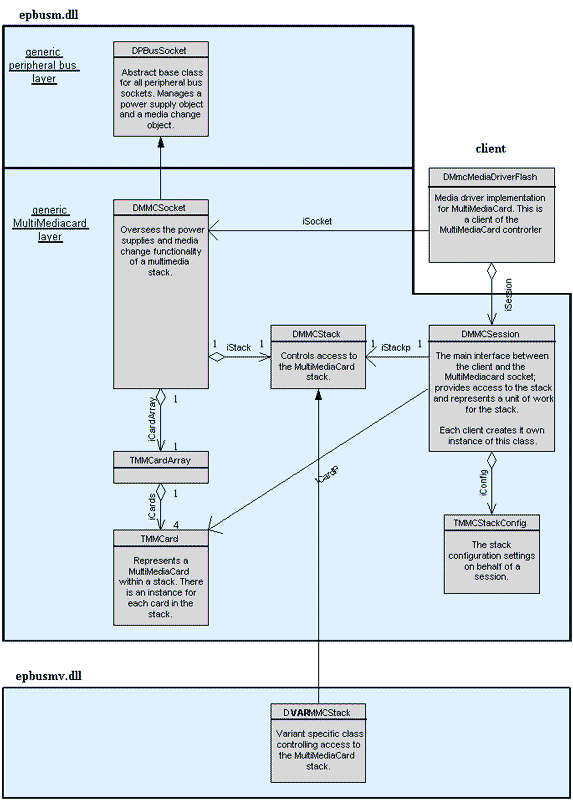Client Tutorial
Explains how to use the MMC Controller interfaces to use MMC hardware.
Client interfaces
The following diagram shows the relationship between the Controller and its clients, and also shows aspects of the relationship between the constituent parts. In this case, the client is the MultiMediaCard driver, although in general this could be some other device driver.
The session is used to pass commands either to the entire stack, i.e. a broadcast command, or to individual cards in the stack.
The session provides access to the stack of cards, via a pointer to a stack object, the iStackP private member. The session is used to pass commands either to the entire stack, i.e. a broadcast command, or to individual cards in the stack. An individual card can be accessed via a pointer to the card object, the iCardP private member. The card objects, TMMCCard types, are data members of the card array object, TMMCardArray, which, in turn is a data member of the stack object.
Using the MultiMediaCard stack
Clients of the MMC Controller such as the MMC Media Driver uses the MMC Controller as follows:
requests a pointer to the stack object, through which the client can obtain pointers to the individual card objects and interrogate the cards, finding out their media type, capacity, and capability (via the card’s TCSD object), and whether the card is present or ready.
creates a session object, an instance of the DMMCSession class, providing a callback function for its constructor. The callback is encapsulated as a TMMCCallBack object.
initiates the session with the pointer to the stack object: DMMCSession::SetStack() .
The client interacts with the stack in the following manner:
it sets the session up with the pointer to the card object, by calling DMMCSession::SetCard().
it sets the session up to do a specific job, such as a MultiMediaCard macro command, or a lower level card command, using the API provided by DMMCSession.
it presents the session to the stack for execution, by calling DMMCSession::Engage().
On completion, the stack calls the client’s callback function. The client then can repeat the cycle from step 1 or 2.
The client can override the default bus configuration settings, i.e. change the bus clock, enable retries, change time-out values, restore defaults etc., using the session's stack configuration object, TMmCStackConfig, although in practice, there is rarely a need to do this.
Locking the MultiMediaCard stack
The DMMCSession API includes general lower level functions to issue any single command or series of commands including those currently unknown to the controller. This allows application specific commands to be supported. It also allows the controller to support new commands introduced in later versions of the specification (e.g. commands to support I/O cards).
When issuing a series of application specific commands, the client will want to lock the stack, preventing any other client from generating bus activity during this period. This is accomplished by calling DMMCSession::SetupCIMLockStack() and then engaging that session. If successful, the stack will be locked until DMMCSession::UnlockStack() is called.
As it may take time for the controller to lock the stack for that session, the mechanism for locking the stack involves submitting a session even though no bus activity results. If this session completes successfully then the stack is locked. The client can then go ahead and invoke its series of commands - configuring that same session object as necessary each time and submitting it.
Copyright ©2010 Nokia Corporation and/or its subsidiary(-ies).
All rights
reserved. Unless otherwise stated, these materials are provided under the terms of the Eclipse Public License
v1.0.
